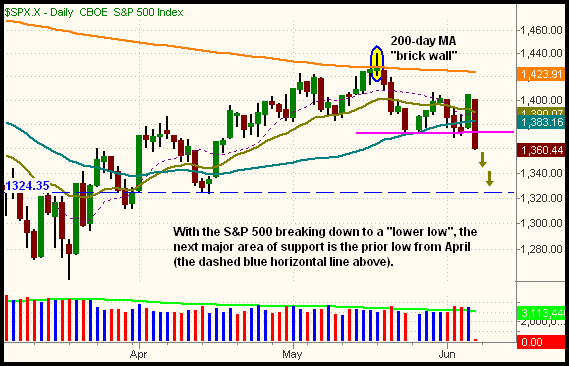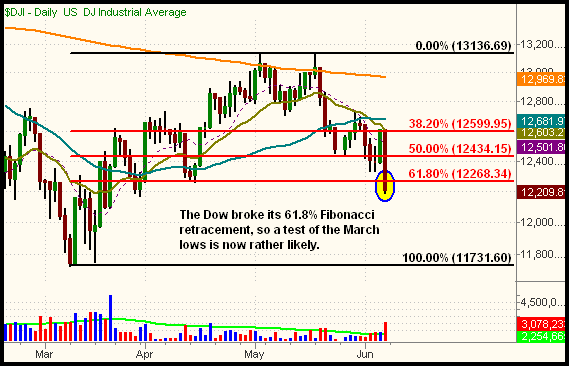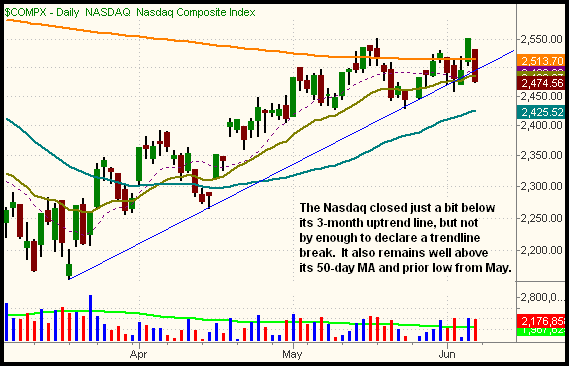|
The Wagner Daily ETF Report For June 9
In last Friday morning's commentary, we said, "With the S&P 500 in 'no man's land,' the Dow still below major resistance levels, and the Nasdaq trying to break out to a new intermediate-term high, the major indices are obviously out of sync with one another. Whenever this occurs, trading typically becomes whippy and indecisive." The subsequent action that followed that day certainly proved our expectation of indecision!
Last Thursday, stocks gapped higher on the open, then built on their gains throughout the session, but the exact opposite scenario occurred on Friday. Instead, the broad market opened lower, then continued trending down throughout until the closing bell. When the dust settled, the major indices had followed up Thursday's impressive average gains of 2% by plunging approximately 3% on Friday. The S&P 500 and Dow Jones Industrial Average suffered identical losses of 3.1%, as the Nasdaq Composite tumbled 3.0%. Even the small-cap Russell 2000, which had been showing relative strength to the broad market, fell 3.0%. The S&P Midcap 400 lost "only" 2.6%. Inverse of the previous day's closing action, all the main stock market indexes finished at their intraday lows.
Total volume in the NYSE surged 17% above the prior day's level, causing the S&P 500 to register a bearish "distribution day." Trading in the NYSE rose to its highest level since April 1 of this year, but that's obviously negative considering the higher turnover correlated with massive losses. Institutional selling in the Nasdaq, however, was less prevalent. Turnover in the tech-heavy Nasdaq eased 1%. Nevertheless, market internals were atrocious across the board. In the NYSE, declining volume crushed advancing volume by a margin of nearly 12 to 1. The Nasdaq adv/dec volume ratio was negative by approximately 9 to 1.
The S&P 500 finally joined the Dow Jones Industrials by making a "lower low" on its daily chart. This occurred when last Friday's sell-off shoved the S&P below support of its prior lows from May. On the daily chart of the S&P 500 below, we've annotated a few other notable points:

The solid pink horizontal line on the chart above marks last Friday's key break of price support that caused a "lower low" to be formed. The new intermediate-term downtrend began with the high of May 19 (circled in pink). Remember how much we were talking about the 200-day moving average being like a brick wall? If so, it should not be surprising that the test of the 200-day MA on May 19 marked the high of the bounce off the March 2008 lows. With the S&P now firmly below its 20 and 50-day moving averages, as well as its prior lows from last month, we expect to see further weakness in the near-term. If that happens, next major price support for the S&P should be found near the April 2008 low (the dashed blue horizontal line). Further, support of the 61.8% Fibonacci retracement from the March 2008 low to the May 2008 high is also near that same level (1,326). A drop in the S&P 500 down to this area would be an ideal place to cover near-term short positions, and prepare for possible re-entries on the long side of the market.
In a much more precarious position, the Dow Jones Industrial Average slid to new lows within its intermediate-term downtrend. Showing relative weakness within the stock market, recall that the Dow had already broken down below its May lows several days ahead of the S&P 500. Perhaps most concerning about the Dow is that last Friday's pounding caused the index to lose support of its 61.8% Fibonacci retracement from the March 2008 low to May 2008 high. In uptrends, a pullback to the 61.8% retracement level is typically considered the "last line of defense" that prevents a complete reversal back to the lows. Unless the Dow suddenly roars back today, odds are now good the index will soon lead the rest of the main stock market indexes in testing its 52-week low. We've annotated the break of the 61.8% Fibonacci retracement on the Dow's daily chart below. Also, note the double top that caused the Dow to instantly reverse after running into its 200-day MA twice last month:

The Dow's weakness last week pushed our position in UltraShort Dow 30 ProShares (DXD) to an unrealized gain of more than 3 points. We have tightened the stop to protect some of our gain in the event of a reversal, but the price action has shown us no reason to take profits yet. Instead, we plan to lock in profit on half the share size into the Dow's next moderate downward move, while keeping the remaining half of the position with a loose stop, just in case downward momentum in the Dow really starts to pick up.
The Nasdaq Composite, which closed at a new five-month high just two days ago, has already fallen back below both its 20 and 200-day moving averages. It also closed just a tad below its three-month uptrend line, but not by a wide enough margin to declare a clean break of trendline support. Still, despite last Friday's nasty reversal, the Nasdaq continues to show relative strength and a much stronger chart pattern than both the S&P and Dow. Specifically, it's still well above its 50-day MA, as well as its prior lows from last month. If the stock market dazzles us with another whipsaw move back up, the Nasdaq is still the place to be:

The small-cap Russell 2000 and S&P Midcap 400 are discussed much less often than the S&P 500, Nasdaq, and Dow. However, they collectively have a tendency to lead the broad market in both directions by outperforming in uptrends, and underperforming in downtrends. Acting even better than the Nasdaq, both indexes convincingly broke out of consolidation to their highest prices of this year just two trading days ago, but you can probably assume what happened. Both indexes closed the week below their lows of the breakout day, and back within their prior bases of consolidation. As discussed last week, failed breakouts usually reverse lower quite rapidly. If the Russell and S&P Midcap indices start to catch up with the bearish patterns in the S&P 500 and Dow, there will be very few pockets of market segment strength in which to seek refuge.
Last Friday's sell-off means the broad market trends are now "down" for all three timeframes: near-term, intermediate-term, and long-term. A pattern of "lower highs" and "lower highs" is now prevalent in each of those timeframes, though the near and intermediate-term trends of the Nasdaq might be the exception. In the big picture, don't forget that stocks have been in a primary downtrend since last October. We must therefore assume the recent March through May rally was merely a counter-trend bounce from "oversold" conditions. If you have been a subscriber for the past several months, you already know this is what we have contended all along. Keep those stops in place and remember to trade what you see, not what you think!
Open ETF positions:
Long - DXD, DUG, SMH
Short - (none)
Deron Wagner is the Founder and Head Trader of both Morpheus Capital LP, a U.S. hedge fund, and Morpheus Trading Group, a trader education firm launched in 2001 that provides daily technical analysis of the leading ETFs and stocks. For a free trial to the full version of The Wagner Daily or to learn about Wagner's other services, visit MorpheusTrading.com or send an e-mail to deron@morpheustrading.com.
|